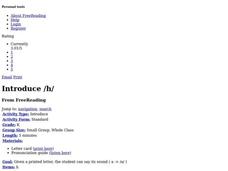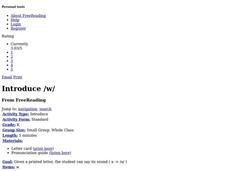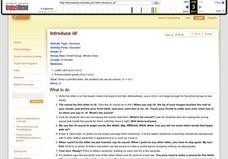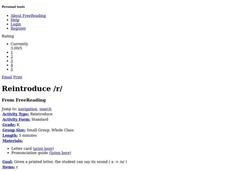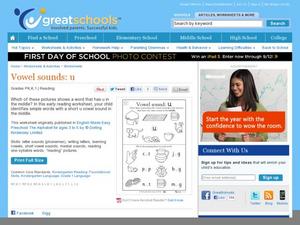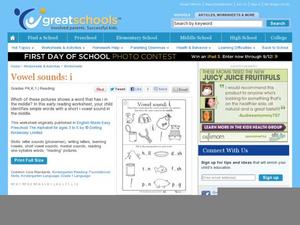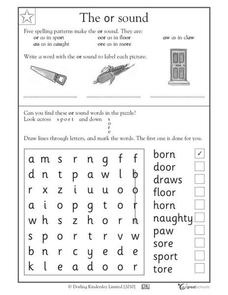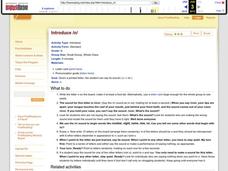Curated OER
Rainbow Spelling: A Kinesthetic Approach to Encoding
Have your young learners interact with phonemes through this tactile plan! Each learner will have a colored mat where they connect different phonemes to create words. The best part is that they can self-correct easily as they spell!
Curated OER
Oh Say Can You DDDD!
Young readers see that letters represent phoneme sequences in spoken words. They identify the letter "d," and recognize "d" in spoken words by exploring the meaningful representation and a letter symbol. They practice finding the letter...
Curated OER
Introduce /h/
Explore the letter h using these strategies combining pronunciation, recognition, letter sound, and word examples. Scholars examine the letter shape and listen to you pronounce the /h/ sound. As you explain how this sound is...
Curated OER
Introduce /w/
Get to know the ins and outs of the letter w using these strategies combining pronunciation, recognition, letter sound, and word examples. Scholars examine the letter shape and listen to you pronounce the /w/ sound. Use these tips...
Curated OER
Introduce /j/
Learn the ins and outs of the letter j using these strategies combining pronunciation, recognition, letter sound, and word examples. Scholars examine the letter shape and listen to you pronounce the /j/ sound. Use these tips to...
Curated OER
Introduce /p/
Navigate the letter p without leaving anything out: combine pronunciation, recognition, letter sound, and word examples. Scholars examine the letter shape and listen to you pronounce the /p/ sound. As you explain how this sound is made,...
Curated OER
Introduce /d/
Give youngsters a better grasp of the letter d by combining letter sounds, pronunciation, recognition, and word examples. Scholars examine the letter shape then listen to you make the /d/ sound and try it on their own....
Curated OER
Introduce /u/
As scholars are learning about letter sound correspondence use this activity to help them with the /u/ sound. Learners examine a large u on the board, identifying it if they can. They listen to you make its sound, explaining to...
Curated OER
Reintroduce /r/
The /r/ sound can be a difficult one, but scholars use some helpful tips to get it right. After examining the letter shape they listen to you pronounce this phoneme and describe what you are doing to create the sound. They try on their...
Curated OER
Reintroduce /o/
There are many words that begin with the /o/ sound; scholars study this letter in multiple contexts including intial phoneme examples, pronunciation, and letter recognition. Write the letter on the board to see if learners can identify...
Curated OER
Reintroduce /b/
Combine letter sounds, pronunciation, recognition, and word examples in one exercise by following these strategies. Scholars examine the letter b and identify it if they can. As they listen to you make the /b/ sound, youngsters try...
Curated OER
Introduce /y/
As you come to an end in your alphabet study, use these strategies to examine the letter y. Scholars examine the letter shape and listen to you pronounce the /y/ sound. Use these tips to explain how you do it as they try. Can they...
Curated OER
Vowel Sound: u
Which of these have /u/ as a middle sound? There are images of seven CVC words surrounding the letter u here, and scholars draw lines from the letter to words with the same middle phoneme. Be sure they know what these images are...
Curated OER
Vowel Sound: i
As scholars become more comfortable with initial sound correspondence, introduce them to medial sounds. As they focus on the vowel sound /i/, youngsters examine a set of images and draw a line from the letter i to any with that...
Curated OER
The or Sound
Before using this vowel sounds crossword activity, be forewarned that the pronunciation here is based on British English, and will be confusing for American English speakers. Learners focus on the /or/ sound, examining five spelling...
Curated OER
Introduce /o/
The best way to get your scholars familiar with the alphabet is to expose them to each letter in multiple contexts. This strategy incorporates letter recognition, sound, word examples, and pronunciation, and emerging readers will feel...
Curated OER
Introduce /g/
As your emerging readers are learning the alphabet, set them up for success with strategies like these that incorporate multiple contexts and learning styles. Focusing on the letter g, write it clearly on the board. Model the /g/...
Curated OER
Reintroduce /t/
Use these strategies to connect letter pronunciation, sound, word examples, and recognition, focusing on the letter t. Emerging readers examine the letter and listen to you say the /t/ sound. As you explain how to do it, they try...
Curated OER
Reintroduce /f/
Draw a large letter f on the board to begin this letter recognition and sounds activity, asking kids to identify it if they can. Demonstrate the /fff/ sound and explain how you are making it as learners try it out. What words can...
Curated OER
Introduce /n/
What is this letter? Once your class is ready to explore the letter n, use these strategies to combine word examples, pronunciation, and letter recognition. First, can they identify the letter? Make the /n/ sound, explaining...
Curated OER
Reintroduce /v/
Combine letter recognition, sound, and pronunciation using this strategy for pre-readers. Use these letter cards or write the letter v on the board, asking scholars to identify it. Then, model the /v/ sound as you explain how...
Curated OER
Reintroduce /l/
Connect letter recognition, pronunciation, sound, and word examples to give scholars a solid grasp on the letter l. They watch you draw a large l on the board and make the /lll/ sound. Using your tips, they try the sound on...
Curated OER
Reintroduce /e/
These inventive strategies help emerging readers focus on the letter e, forming sound associations along with letter recognition. Explain the mouth movement in making the /eee/ sound, asking learners to try it. Can they think of words...
Curated OER
O
As part of a series of alphabet worksheets, learners focus on the letters p and o. They begin by tracing the lowercase letters, using the space to print a few on their own. Next, scholars connect the letter to images that begin...




